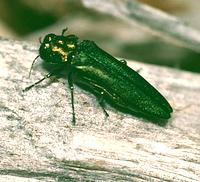Iowa Scientist Battles Emerald Insect for Ash Survival
AMES, Iowa, September 15, 2009 (ENS) - The emerald ash borer is eating its way through all of the native ash trees across the United States, but Iowa horticulturalist Mark Widrlechner is locked in a battle with the devastating insect. He is collecting and storing ash tree seeds as fast as he can - seeds that can serve as a national resource for reintroducing ash trees once the insect can be controlled.
Assistant professor of agronomy and horticulture at Iowa State University, Widrlechner is a curator at the North Central Regional Plant Introduction Station in Ames, Iowa.
"When I first found out about the emerald ash borer, we had about 60 different types of ash tree germplasm [seed] in our system," said Widrlechner. "Now we have about 220. Ultimately, I think we'll need at least a couple thousand to represent the diversity that's out there. In the next two years, we should really start to make a dent in it."
First discovered near Detroit, Michigan in June 2002, the emerald ash borer has wiped out ash trees in widening circles across the country.
Borers have killed tens of millions of ash trees in southeastern Michigan, with tens of millions more lost in Illinois, Indiana, Kentucky, Minnesota, Missouri, New York, Ohio, Ontario, Pennsylvania, Quebec, Virginia, West Virginia, and Wisconsin.
As of June, estimates from New York put the total number of ash trees destroyed in that state alone at 70 million.
The adult beetles nibble on ash foliage but cause little damage. The immature insects feed on the inner bark of ash trees, disrupting their ability to transport water and nutrients.
 |
Emerald ash borer, Agrilus planipennis (Photo courtesy USDA) |
"Where these borers have been present the longest, it has basically been a total wipeout," says Widrlechner.
"That is something we rarely see in nature," he said. "It's uncommon for a pest to come in and just clean something out. It doesn't just attack sick trees. Emerald ash borer attacks healthy trees. It attacks small trees. So you don't have just big, old trees falling to this, you've got two to three inch saplings falling to this."
Scientists believe the insect probably arrived in the United States on solid wood packing material carried in cargo ships or airplanes originating in its native Asia.
To find ways of containing the pest, saving the ash trees and conserving their seeds, many federal government agencies are working with Widrlechner, who became the national coordinator for seed collection and conservation in January.
The situation has mobilized members of the U.S. Department of Agriculture's Agricultural Research Service, the U.S. Forest Service, the Animal and Plant Health Inspection Service, the Natural Resources Conservation Service, the Bureau of Land Management and many state agencies and public gardens.
"We've got a lot of people working on it," he said. "I just got back from southern Wisconsin and northern Illinois looking for good, natural populations that have seed. We find them, mark them with the GPS coordinates and then go back when the seeds are ready in September and October."
Once Widrlechner collects the seeds, he stores them in the Plant Introduction Station and also at a secure backup site at the National Center for Genetic Resources Preservation in Fort Collins, Colorado.
 |
An Ohio ash tree attacked by emerald ash borers (Photo courtesy Ohio State University) |
The Plant Introduction Station is a joint project of Iowa State University, the USDA and the State Agricultural Experiment Stations of the 12 north central states as part of the National Plant Germplasm System. The facility keeps an inventory of many types of seeds, which are used in research locally and sent to researchers around the world.
The effect of losing the nation's ash trees would be painful. The ash is a popular shade tree along streets and in residential landscapes. Native Americans use ash trees for baskets and other crafts, and baseball bats are traditionally made from the wood.
Widrlechner says the biggest problem might be in the hole created in the ecosystem. "I'm really concerned. "You take a major tree out of the forest and what is going to fill the hole? Another native tree might do it or something non-native could fill the gap and change the ecosystem."
Research is underway to understand the beetle's life cycle and find ways to detect new infestations, control adults and larvae, and contain the infestation.
States have quarantines in place to prevent infested ash firewood, logs or nursery trees from being transported and starting new infestations elsewhere.
Insecticides have shown potential for protecting trees from the borer, including soil-applied systemic insecticides, trunk-applied systemic insecticides, and protective cover sprays applied to the trunk, branches, and foliage.
Hope lies with a new pesticide that lasts up to two years and is 99 percent effective, killing adult ash borers and their larvae.
The emamectin-benzoate-based pesticide Tree-age was developed by the Swiss agrochemical company Syngenta and the Massachusetts firm Arborjet.
The U.S. Environmental Protection Agency has approved Tree-age for use in Michigan, Indiana, Ohio and West Virginia. Approval is also expected for other states.
The best chance of survival for American ash trees lies in the possibility that the insect can be controlled in time for Widrlechner's seed saving and tree restoration work to come to fruition.
Copyright Environment News Service (ENS) 2009. All rights reserved.
To subscribe or visit go to: http://www.ens-newswire.com